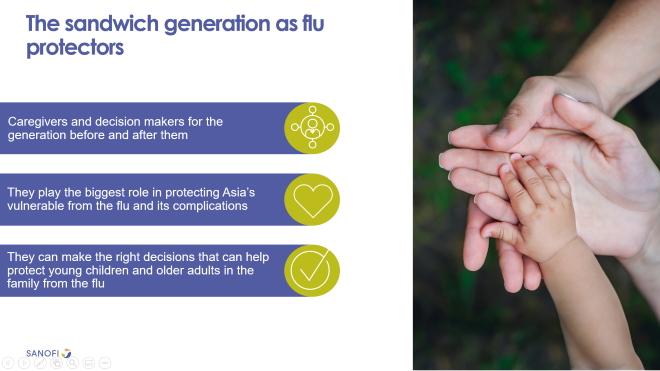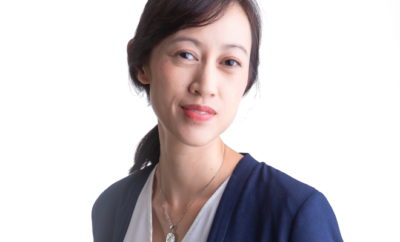
Health x Wellness
What you need to know about being a flu protector
The Active Age attended a roundtable organised by Sanofi Pasteur taking place alongside an Influenza Conference. The roundtable was themed around the hidden complications of flu and what the sandwich generation needs to know. The risks are often under recognised for two populations including young children and the very old.
Roundtable participants included:
- Dr Su-Peing Ng, Global Medical Director, Sanofi Pasteur
- Professor Robert Booy, The University of Sydney, Australia
- Professor Stefan Gravenstein, Brown’s Schools of Medicine and Public Health
- Professor Ping-Ing Lee, National Taiwan University
According to the World Health Organisation (WHO), there are between 3 – 5 million cases of severe flu reported worldwide each year. It is a contributing factor to nearly 50 per cent of the top causes of death worldwide.
The underestimated burden of flu, and the role of the sandwich generation as flu protectors by Dr Su-Peing Ng
Dr. Ng opened the roundtable providing an overview about the flu virus. She covered the differences between having a cold and the flu. Typically, with the flu, there is a more abrupt onset, and the fever, aches, fatigue and chills are more common symptoms as compared to the cold. Colds are caused by many different viruses and vaccines are not meant to prevent it.
The burden of flu is substantially under-reported and can lead to severe complications including pneumonia, heart attack and stroke. Complications can happen to people of any age but vulnerable populations can be more impacted, for example, those with diabetes or a heart condition.
Age increases susceptibility to infection, with older adults being most at risk for flu infection and serious complications. 10 percent of older adults who have been hospitalised because of flu experience loss of independence in more than 3 basic daily living activities.
In Asia, an estimated 20 percent of the working-age population are of the sandwich generation. Often, it’s the young and older population who suffer most from the flu. With working-age people, the impact is typically a loss of productive time that is spent recovering from the flu.

The ‘Sandwich Generation’ plays an important role as flu protectors:
- As caregivers for family members, both young and old
- Help the more vulnerable members become protected from the flu and associated complications
- Support, and in some cases, help make the right decisions in terms of protecting the young and old
In Asia, flu vaccine coverage rates are low for both young and old. Most Asian countries struggle to reach the levels observed in western countries. Factors contributing to this situation include:
- People underestimating the value of the vaccine or the consequences of the flu
- Accessibility to the vaccine
- Understanding about how the vaccine helps
- Information (and sometimes endorsement) by a medical practitioner about the effectiveness
Why fly protection in children and older adults matters for them and the whole family by Professor Booy and Professor Gravenstein
Children are great transmitters of infection and are of risk to their parents and caregivers.
Professor Booy
There’s a direct benefit in ensuring that they are protected from the flu and saving their parents and possibly elder caregivers from the implications and consequences.
Professor Booy shares about the ‘Ring of Protection’, that provides indirect (‘herd’) protection to a population that has been vaccinated. This is important in breaking the transmission path and results in a lesser number of infected people.

Pregnant women can be vaccinated for flu and this protection extends to their children through the womb, and greatly reduces the risk 6-month and younger babies experience if they catch the flu. This age segment is particularly prone to complications leading to hospitalisation.
Flu vaccine is effective in children and research shows that there is high effectiveness for children younger than 3YO. This can result in lesser impact to parents due to lower absenteeism, and with children through lesser risk of ear infections, or related infections.
The flu is responsible for 10 percent of respiratory hospitalisations in children under 18YO worldwide.
For older adults, the flu virus can cause more complications such as infections, inflammation leading to blood clots. If these persons also have other health conditions such as heart conditions, diabetes or obesity, this can further increase the severity of the condition.
The concept of cocooning can help to protect the older adults in a family or a household. Vaccinating the child can help to protect the grandparents. The sandwich generation has a role to play in helping identify such scenarios and help to break the transmission chain. When we get vaccinated, we help the different generations within a family, and to a larger extend, our immediate community. This community can include our children’s playmates at school, our colleagues, and our parents’ friends.
A flu vaccine’s value goes beyond preventing the flu, and extends to possibly helping prevent heart attacks and strokes in older family and community members.
According to Professor Gravenstein’s sharing, many people decided to get themselves or their children vaccinated when they realise how this single step can help to reduce either the risk or complications that children or older adults might experience because of the flu. The sandwich generation can play a major role in helping make decisions for their family and household.
Asia’s flu preparedness by Professor Ping-Ing Lee
Professor Lee spoke towards how prepared Asia is with the flu and that vaccination is critical.
Influenza is split into seasonal and pandemic categories; seasonal influenza goes through minor mutations and this is what we see on a somewhat annual basis whereas a pandemic influenza goes through a major mutation and associated with the virus spreading across species.
Most countries in Asia fully recommend vaccination with at least 90 percent of governments providing partial to full funding. Singapore recently announced that subsidies for all vaccinations will be extended to general practitioner (GP) clinics under the Community Health Assist Scheme by 2020. This programme does not extend to the flu vaccine though.
For example, in Taiwan, government funded influenza vaccination covers all high-risk groups such as the elderly above 50YO, children 6 months – 18 YO, pregnant women, healthcare workers, parents of children younger than 6 months.
The WHO believes that effective educational programmes and communications can result in successful introduction of influenza vaccines to healthy younger populations, including pregnant women and young children.
By fully vaccinating a country population, it can also help to tackle pandemic influenza if and when it happens. Some best practice shared from the US included making the flu vaccine more accessible and easier:
- In the US, people can buy and arrange to take the flu shot at a pharmacy; and location-wise, the pharmacy can be based in convenience locations such as a supermarket.
- US policy supported the accessibility by allowing pharmacists to administer the vaccine instead of requiring a doctor or nurse to do so.
General tips to protect yourself from the flu
- Get your flu shot – the most effective way to prevent influenza is through vaccination
- The flu shot needs to be taken every year; due to seasonal influenza and the reducing efficiency of the vaccine over time
- Avoid being around people who are sick
- Regular hand washing









